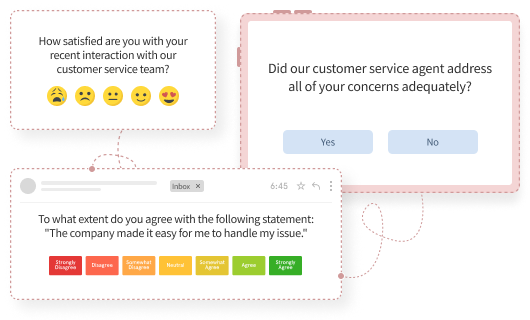Imagine this scenario: A frustrated customer calls your support line, seeking help with an urgent issue. Your agent, well-trained and confident, not only resolves the problem but leaves the customer feeling valued and understood. The result? A satisfied customer, likely to return and even recommend your brand. Now, picture the opposite—an agent who struggles, exacerbating the customer’s frustration. The outcome could be the loss of a loyal client and potential revenue.
In today’s competitive landscape, the performance of your frontline agents isn’t just about closing tickets—it’s about shaping customer perceptions and driving business growth. The question is, how can you ensure your agents are consistently delivering top-tier service?
The answer lies in feedback—specifically, leveraging surveys to gain actionable insights into agent performance. From identifying skill gaps to measuring customer satisfaction, surveys provide the data-driven foundation you need to elevate your team’s effectiveness. But it’s not just about collecting data; it’s about using it strategically.
In this article, we’ll explore the critical role of surveys in improving agent performance. We’ll look at practical examples, the types of surveys that yield the best insights, and how to turn feedback into meaningful action. Let's get started!
TL;DR
- Improving agent performance is crucial as it directly impacts customer satisfaction, retention, and overall business growth.
- By using surveys, you can get actionable insights as they capture customer feedback, identify skill gaps, and track performance trends.
- You can utilize different types of surveys such as Post-interaction Surveys, Customer Effort Score surveys, and Net Promoter Score surveys among others to measure agent performance.
- To improve agent performance with surveys, you can personalize surveys, integrate real-time feedback, use AI for predictions, and create a feedback loop.
- By identifying KPIs, using data for tailored training, and recognizing top performers, you can easily analyze agent survey data and enhance customer service performance.
- Zonka Feedback is a powerful survey software that provides real-time feedback, AI-driven sentiment analysis, and automated follow-ups, helping you improve agent performance through actionable insights and seamless feedback collection. Sign up for a 14-day free trial or schedule a demo to know more about its features and empower your frontline team!
Measure Customer Service Performance
Improve your agent performance with surveys and optimize your team's potential for business growth.

Why is Improving Agent Performance Important?
Picture this: A loyal customer calls your support line, frustrated because their service isn’t working as expected. The agent who answers that call has the power to either defuse the situation or escalate it further. In that moment, the agent is the company in the eyes of the customer. A calm, knowledgeable, and empathetic response can turn a negative experience into a positive one, potentially increasing customer loyalty. On the other hand, a poorly handled interaction could push the customer straight to a competitor.
Agent performance isn’t just about solving problems; it’s about shaping perceptions.
A high-performing agent can close more support tickets on first contact, reducing operational costs. But beyond efficiency, great agent performance enhances customer satisfaction, which in turn boosts retention rates—a critical metric for companies for business growth.
💡According to a study by Salesforce, 88% of consumers are more likely to make another purchase after a positive customer service experience. In an enterprise setting, where each customer can be worth millions, this creates a ripple effect that directly impacts the bottom line.
To add more to your company’s success, you need to understand the customer experience from their perspective. This is where agent feedback help and provide a direct line to customer feedback, allowing you to understand how agents are performing from the customer's perspective.
Role of Surveys in Enhancing Agent Performance with Real-Life Examples
The importance of feedback surveys in improving agent performance can be stated by the fact that 70% of companies that deliver superior customer service use customer feedback to do so, resulting in better business performance. [Source: Forrester] This means that surveys are a critical component of a successful customer service strategy.
By providing a direct line to customer feedback, surveys enable you to identify areas for improvement, measure success, and continuously enhance the skills and effectiveness of their agents.
Let's explore how surveys can revolutionize your agent performance and drive significant business growth.
a. Identifying Knowledge & Skill Gaps
Surveys are invaluable tools for pinpointing specific areas where agents may need improvement, whether it's in product knowledge, communication skills, or customer empathy. By analyzing survey responses, you can identify patterns in customer feedback that highlight these gaps.
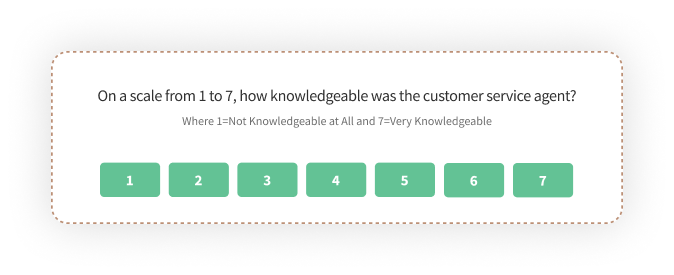
Real-life Example
Amazon, known for its customer-centric approach, uses detailed post-call surveys to evaluate agent performance. If they find that their agents lack in-depth knowledge of specific product categories, they develop targeted training modules for those categories which results in significant decrease in customer complaints within a short span of time.
b. Measuring Customer Satisfaction Directly
Surveys allow you to gauge customer satisfaction in a direct and quantifiable way. By asking customers to rate their experience with agents, you gain a clear understanding of how well your service meets customer expectations.
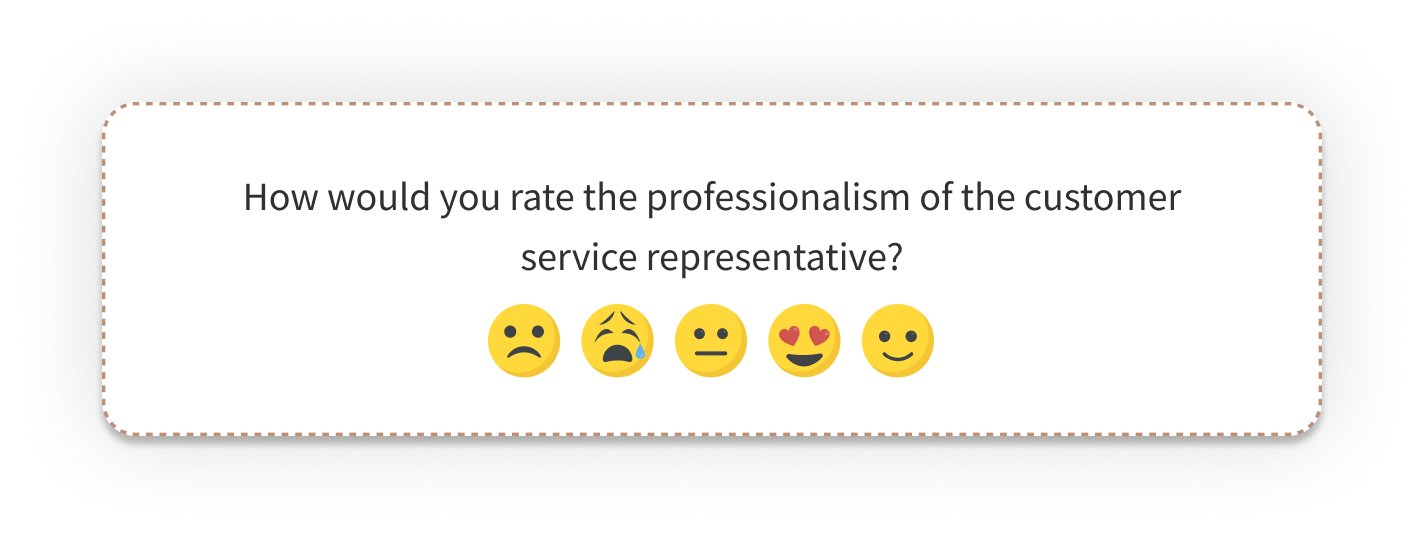
Real-life Example
Marriott International, a global leader in the hospitality industry, regularly surveys guests about their interactions with staff. By focusing on the feedback from surveys, they easily found out areas where service needed improvement. After implementing changes based on survey insights, Marriott saw a 15% increase in their CSAT scores, particularly in their premium and luxury segments.
c. Tracking Trends in Customer Sentiment & Agent Behavior
Over time, survey data can reveal trends in both customer sentiment and agent behavior. These trends help you take proactive measures to address potential issues before they escalate.
You would be surprised to know that companies that successfully act on customer feedback outperform competitors by 85% in sales growth as per report by Harvard Business Review.
Real-life Example
AT&T, a major telecommunications provider, uses survey data to track customer satisfaction trends during peak call hours. The data has previously revealed a consistent drop in satisfaction during these times. By identifying this trend, AT&T was able to optimize staffing levels, leading to a 10% improvement in customer satisfaction during high-traffic periods.
d. Measuring the ROI of Training & Development Programs
Surveys like frontline customer service surveys can be used to assess the effectiveness of agent training and development programs by measuring improvements in customer satisfaction and agent performance. This ensures that resources are being allocated effectively and that training programs deliver tangible results.
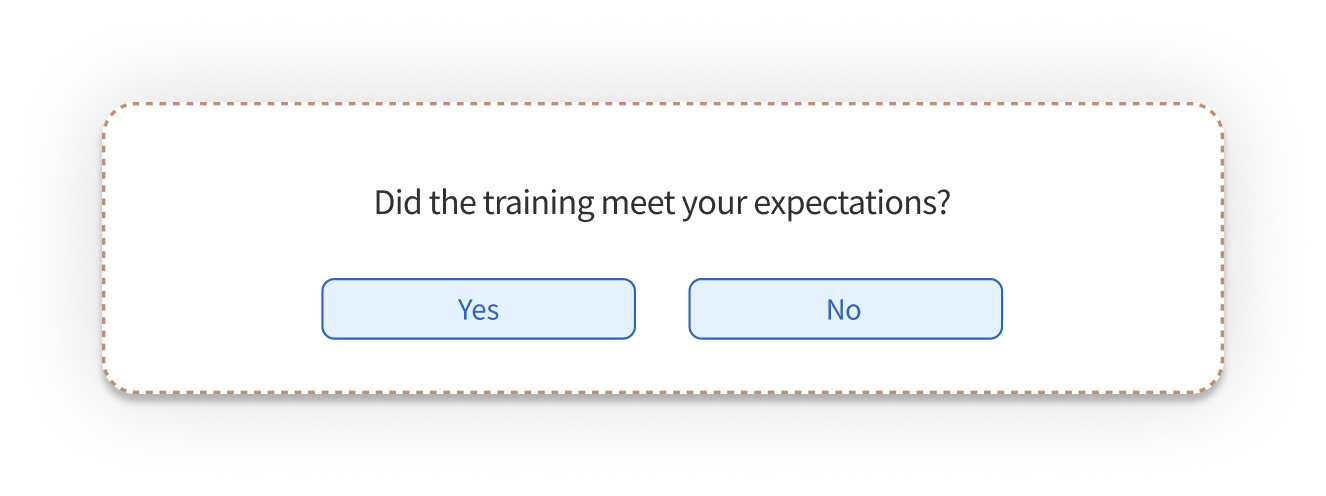
Real-life Example
Citibank has implemented a new customer service training program and used post-training surveys to evaluate its effectiveness. The surveys revealed a 30% increase in customer satisfaction, which directly correlated with a 25% increase in successful cross-selling of financial products. This demonstrated a significant return on investment (ROI) for their training initiatives.
e. Providing Actionable Feedback for Continuous Improvement
Surveys give customers a platform to share detailed feedback, including suggestions for improvement. This feedback is essential for helping agents refine their approach and improve their performance over time. According to Gallup, if you collect and act on customer feedback, you can easily witness a 10% increase in customer retention.
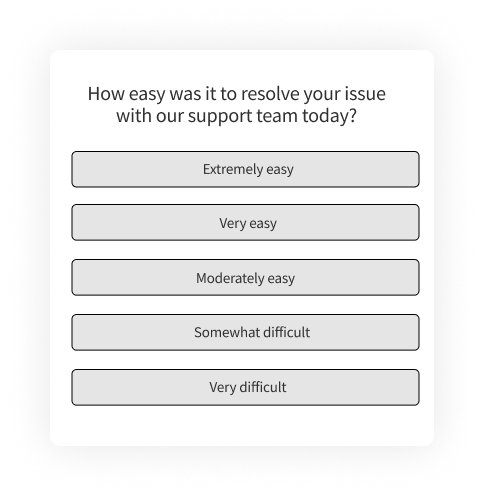
Real-Life Example
Zappos, an online shoe and clothing retailer, is renowned for its exceptional customer service. The company encourages customers to provide specific feedback after every interaction. Zappos agents review this feedback regularly, and this continuous loop of feedback and improvement contributed to a 20% increase in customer loyalty over a single quarter.
Types of Surveys to Measure Agent Performance & their Use Case
While there are many ways to measure agent performance such as First Call Resolution (FCR), Average Handling Time (AHT), and complaint volume, we will focus solely on feedback surveys as they provide direct, actionable insights straight from the source—your customers.
Let us look at the different types of surveys that can help you measure and enhance agent performance.
| Survey Type | Use Case |
| Post-Interaction Surveys | After resolving a support ticket or completing a sales call |
| CES Surveys | After interactions like troubleshooting a problem or navigating a complex service process |
| Customer Satisfaction (CSAT) Surveys | After important milestones, like completing a purchase or resolving an issue |
| Net Promoter Score (NPS) Surveys | Measure loyalty after resolving complex issues or major service completions |
| ESAT Surveys | Periodically to identify internal issues affecting agent performance |
| Training Effectiveness Surveys | After every training session to evaluate the effectiveness of training programs |
| 360-Degree Feedback Surveys | Annually or during performance reviews to gain a complete understanding of agent’s capabilities |
| Mystery Shopper Surveys | Periodically to ensure consistent service quality and identify areas of improvement |
1. Post-Interaction Surveys
Imagine a customer who just finished a call with your support team. They’ve had a frustrating experience, but the agent managed to resolve the issue calmly and efficiently. How do you capture that moment of truth? Post-interaction surveys are designed to do just that.
- What They Are?
These surveys are sent immediately after a customer interaction, whether it’s a phone call, chat, or email. They ask the customer to rate their experience while it’s still fresh in their mind. - Why They Matter?
Post-interaction surveys provide immediate feedback, helping you capture the highs and lows of customer service in real-time. This allows for quick corrective actions if needed. - Use Case
Ideal for assessing agent performance immediately after a customer interaction, such as resolving a support ticket or completing a sales call.
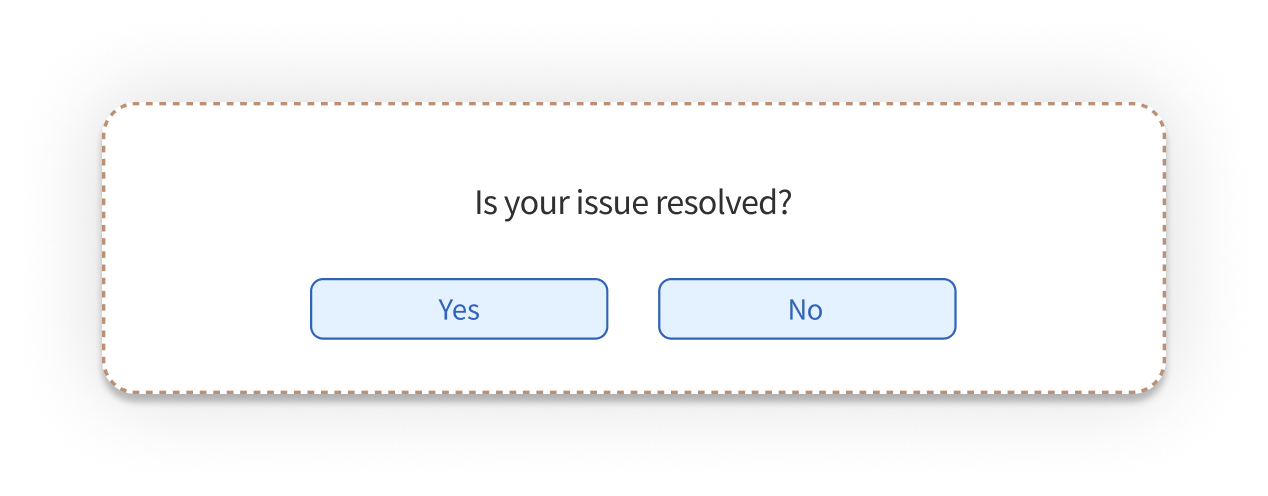
2. Customer Effort Score Surveys (CES) Surveys
Imagine a customer who just navigated through your service process. The issue was resolved, but how easy was it for them? Customer Effort Score (CES) surveys are the agent performance metrics designed to answer that crucial question.
- What They Are?
CES surveys measure the ease of customer interactions, asking customers to rate how much effort was required to complete a specific task, such as resolving an issue or making a purchase. Typically, the survey question might be, “How easy was it to resolve your issue with us today?” with responses ranging from “Very Easy” to “Very Difficult.” - Why They Matter?
CES surveys focus on the customer’s experience with the process rather than the outcome. Research shows that reducing customer effort is one of the most effective ways to improve customer satisfaction and loyalty. When customers find it easy to interact with your service, they’re more likely to return and recommend your company to others. - Use Case
Ideal for evaluating the ease of getting resolution or transaction, especially after interactions like troubleshooting a problem or navigating a complex service process.
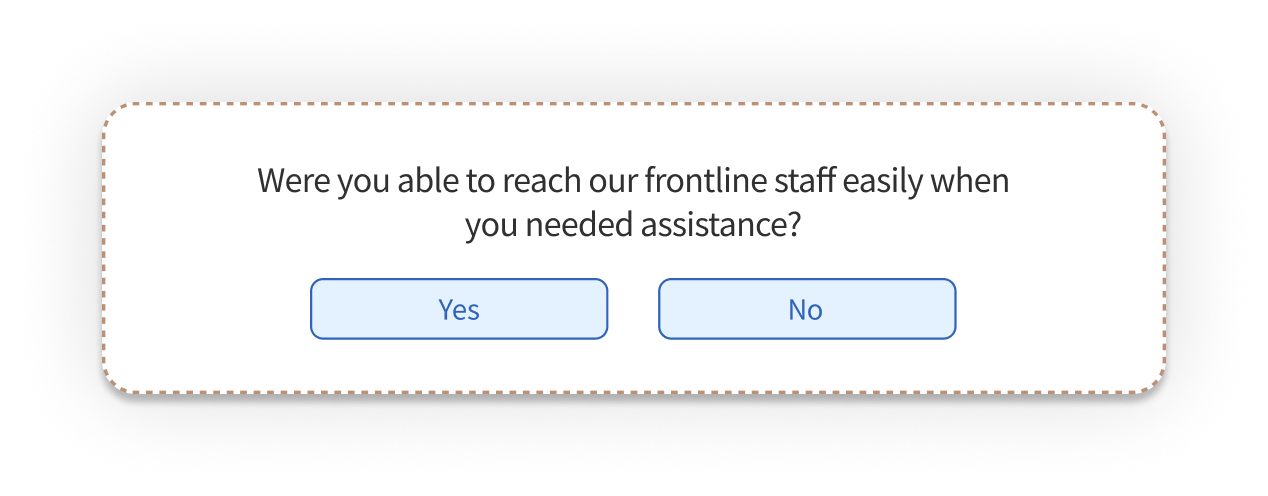
3. Customer Satisfaction (CSAT) Surveys
Imagine a customer who just completed a transaction or had an issue resolved. They’re satisfied, but how satisfied? Customer Satisfaction (CSAT) surveys are the go-to tool for answering this question.
- What They Are?
CSAT surveys typically ask customers to rate their satisfaction with a specific interaction on a scale, often ranging from “Very Dissatisfied” to “Very Satisfied.” These surveys are direct and to the point, providing a clear indicator of how well an agent has performed in the eyes of the customer. - Why They Matter?
CSAT surveys offer a snapshot of customer sentiment, helping organizations quickly identify top-performing agents and those who might need additional support. They allow companies to track trends in satisfaction over time, ensuring that service levels are consistently high. - Use Case
Best used to measure general customer satisfaction with an agent's performance after critical interactions or at key customer journey points, like completing a purchase or resolving an issue.
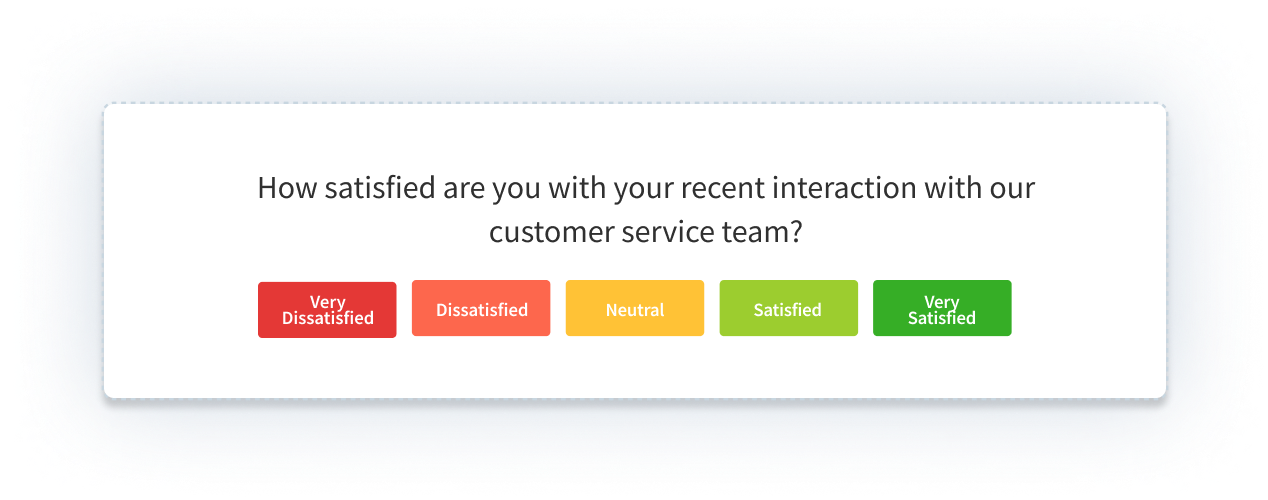
4. Net Promoter Score (NPS) Surveys
If you have wondered whether your customers are a loyal advocate for your brand, NPS surveys are the customer service metric that would reveal the answer.
- What They Are?
NPS surveys ask customers one core question: “On a scale of 0-10, how likely are you to recommend our service to a friend or colleague?” The simplicity of this question, combined with the option to ask follow-up questions, makes NPS a powerful tool for gauging long-term customer relationships. - Why They Matter?
NPS surveys measure customer loyalty, which is a strong indicator of overall satisfaction and agent performance. The follow-up questions allow companies to dig deeper into the reasons behind a customer’s score, providing actionable insights that can improve both agent performance and customer retention. - Use Case
Useful for gauging how likely customers are to recommend your service after key interactions like like the resolution of a complex issue or completion of a service, indicating overall satisfaction and long-term loyalty.

5. Employee Satisfaction (ESAT) Surveys
Happy agents lead to happy customers. Your agents work tirelessly to provide top-notch service but how do they feel about their work environment, the tools they use, or the support they receive? Employee Satisfaction (ESAT) surveys provide those answers.
- What They Are?
ESAT surveys are internal surveys designed to measure how satisfied your agents are with their roles, These surveys ask questions about job satisfaction, work environment, and overall morale, providing a comprehensive view of agent well-being. - Why They Matter?
There’s a strong correlation between agent satisfaction and performance. Happy, well-supported agents are more likely to deliver excellent customer service. ESAT surveys help organizations identify any internal issues that might be affecting agent performance, allowing them to take corrective actions before it impacts customer satisfaction. - Use Case
Use ESAT surveys periodically, such as quarterly or biannually, to monitor agent morale and identify any issues that may be affecting their performance.
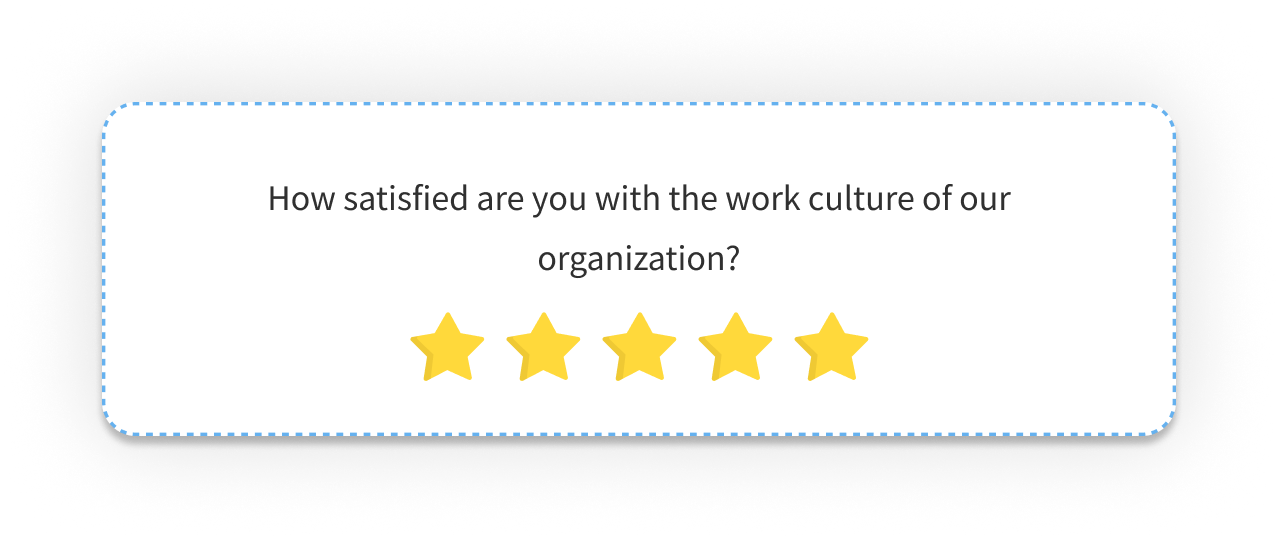
6. Training Effectiveness Surveys
Did your training program pay off? Training effectiveness surveys help you measure the impact of your training efforts.
- What They Are?
Training Effectiveness surveys assess the impact of training programs on agent performance. These surveys ask agents to evaluate the relevance, effectiveness, and applicability of the training they received. This feedback helps organizations determine whether their training programs are delivering the expected results. - Why They Matter?
Training effectiveness surveys ensure that the training provided is actually improving the skills and knowledge of agents, leading to better performance. By understanding which aspects of the training are working and which aren’t, companies can continuously refine their programs for maximum impact. - Use Case
Deploy these surveys after every major training session or program to measure its effectiveness and identify areas for improvement.

7. 360-Degree Feedback Surveys
Imagine a scenario where an agent receives feedback not just from customers but also from peers, supervisors, and even subordinates. 360-Degree Feedback surveys provide this holistic view, helping agents see their performance from all angles.
- What They Are?
360-Degree Feedback surveys gather feedback from multiple sources, including peers, supervisors, and even customers, to provide a well-rounded view of an agent’s performance. This type of survey offers a more comprehensive evaluation by considering different viewpoints, which can uncover strengths and weaknesses that might be missed in traditional surveys. - Why They Matter?
360-degree feedback surveys provide a comprehensive evaluation, helping organizations to develop a deeper understanding of an agent’s capabilities and areas for improvement. This type of feedback is invaluable for personal development and can lead to more targeted training and development programs. - Use Case
Use 360-degree feedback surveys annually or during performance reviews to gain a holistic understanding of an agent’s capabilities and areas for development.

8. Mystery Shopper Surveys
Want to see how your agents perform when they're not being watched? Mystery shopper surveys provide an unbiased assessment of agent behavior and customer interactions. It's like a secret shopper mission to uncover areas for improvement and ensure consistent service quality.
- What They Are?
Mystery shopper surveys involve hiring individuals to act as customers who then report on their experiences with your agents. This method is particularly effective for getting an honest assessment of how agents handle real-life customer interactions without knowing they are being evaluated. - Why They Matter?
Mystery shopper surveys provide insights into how your agents perform when they don’t know they are being watched. This can reveal areas where agents excel or need improvement, offering a true-to-life picture of the customer experience. - Use Case
Use mystery shopper surveys periodically to ensure consistent service quality and to uncover blind spots in agent performance that other surveys might miss.

How Can the Performance of an Agent be Improved with Surveys?
Using surveys like customer service surveys, NPS surveys, and CES surveys not only help to improve agent but also enhance overall customer satisfaction. This can be easily done by using an effective survey tool or form builder software that not only offers surveying options but a comprehensive suite of features that can come in handy to analyze data, track trends, and implement actionable insights for continuous improvement. Here are some strategies to effectively use surveys for boosting agent performance:
a. Personalize Surveys Based on Agent Performance
Personalizing surveys based on an agent’s past performance ensures that the feedback they receive is directly relevant to their individual strengths and weaknesses. This targeted approach helps agents focus on specific areas that need improvement, leading to more effective development and quicker performance enhancements. For this, you can:
- Tailor Survey Questions: Customize survey questions for each agent based on their previous feedback. For example, if an agent struggles with communication, include questions that focus on clarity and tone in customer interactions.
- Segment Feedback by Skill Areas: Create different sections in the survey that address various skill sets, such as technical knowledge, empathy, and problem-solving. This allows for more granular feedback that agents can act on.
- Provide Individualized Coaching Plans: Use the personalized survey data to develop bespoke coaching sessions that address the unique challenges each agent faces, ensuring more relevant and impactful training.
b. Integrate Real-Time Feedback into Agent Dashboards
Integrating real-time feedback into agent dashboards allows agents to see their performance metrics as soon as customer surveys are completed. This immediate insight enables them to make quick adjustments to their approach, fostering a culture of continuous improvement. You can further:
- Include Visual Performance Indicators: Use color-coded indicators (e.g., green for good, red for needs improvement) to give agents a quick visual summary of their feedback, helping them easily identify what actions to take.
- Incorporate Immediate Coaching Tips: Alongside feedback, provide automated coaching tips or suggestions based on the survey results. For instance, if feedback indicates low empathy, suggest strategies for demonstrating empathy in future interactions.
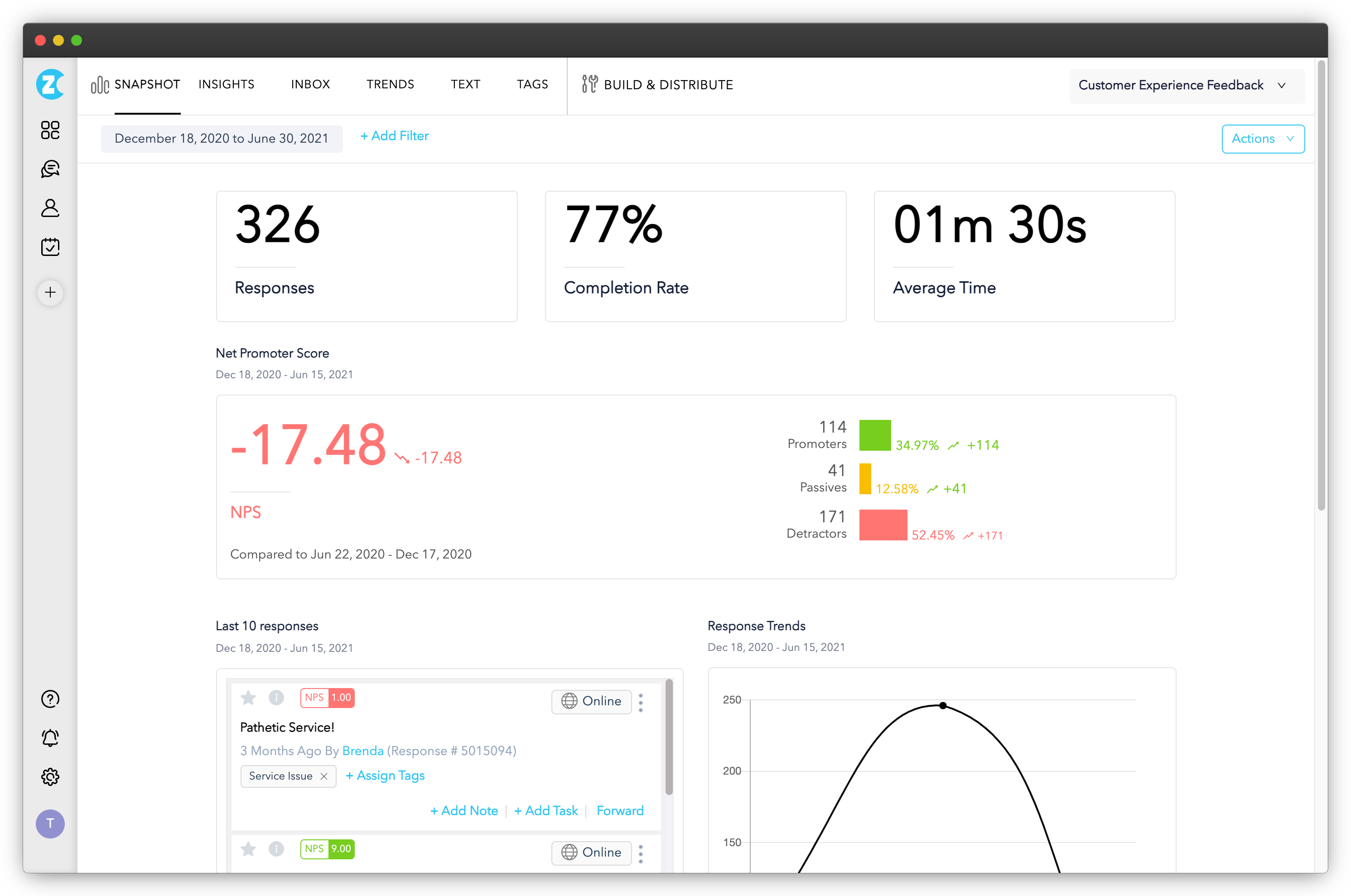
c. Gamify the Survey Process for Agents
Gamifying the survey process can make receiving and acting on feedback more engaging for agents. By turning performance improvement into a game, with rewards and recognition, you can boost motivation and encourage agents to consistently strive for better results. To do so, you can:
- Create Leaderboards: Introduce a points system where agents earn points for positive feedback and rank on a leaderboard. This fosters healthy competition and encourages continuous improvement.
- Offer Incentives: Reward agents with badges, bonuses, or other incentives for achieving certain milestones, such as consistently high customer satisfaction scores.
- Set Up Challenges: Organize monthly or quarterly challenges where agents compete to improve specific metrics, such as first call resolution or CSAT scores, with prizes for top performers.
d. Use AI to Predict & Prevent Performance Issues
AI can analyze survey data to identify patterns that predict potential performance issues before they arise. By proactively addressing these issues, you can prevent declines in performance and maintain high standards across your team. Further, you can:
- Implement Predictive Analytics Tools: Use AI to monitor survey feedback and flag agents who show early signs of underperformance, such as declining customer satisfaction scores or increasing call handling times.
- Automate Proactive Interventions: Set up automated systems that trigger interventions—like additional training or one-on-one coaching sessions—when AI detects potential performance issues.
- Track Long-Term Trends: Use AI to analyze long-term trends in survey data, helping you identify systemic issues that might affect multiple agents and require broader process changes.
e. Create a Feedback Loop with Customers
Establishing a feedback loop with customers ensures that the changes made based on survey results are aligned with customer expectations. It also helps build trust with customers, as they see that their feedback leads to tangible improvements. You can ensure to:
- Follow-Up Surveys: After implementing changes based on initial feedback, send follow-up surveys to customers to assess the impact and gather further insights.
- Communicate Changes: Regularly inform customers about the improvements made as a result of their feedback, either through emails or in-app notifications. This reinforces the value of their input.
- Case Studies: Develop case studies showcasing how customer feedback has led to tangible improvements in agent performance, and share these internally to highlight the importance of continuous feedback.
f. Use Surveys to Design Personalized Agent Development Plans
Establishing a feedback loop with customers ensures that the changes made based on survey results are aligned with customer expectations. It also helps build trust with customers, as they see that their feedback leads to tangible improvements. Additionally, you can:
- Customized Training Modules: Develop training modules based on survey feedback that addresses each agent’s unique challenges, ensuring that development efforts are both relevant and effective.
- Individual Development Plans: Create personalized development plans that map out each agent’s growth trajectory, using survey data to set goals and track progress over time.
- One-on-One Coaching: Use survey insights to inform one-on-one coaching sessions, focusing on the specific areas where each agent can benefit the most from personalized guidance.
Analyzing Survey Data to Improve Agent Performance
Survey data is a treasure trove of insights, waiting to be mined to improve agent performance. But how do you turn raw data into actionable steps that elevate your customer service team? Let’s break it down.
1. Identifying Key Performance Indicators (KPIs)
The first step in improving agent performance is defining what success looks like. This starts with identifying the right KPIs that align with your business goals.
- Define Your Objectives: Begin by clearly outlining the specific objectives you want to achieve through your agent performance initiatives. Are you aiming to reduce customer churn, improve satisfaction, or increase efficiency? Your goals will guide your KPI selection.
- Select Relevant Metrics: Choose KPIs that directly reflect your objectives. For example, if your goal is to enhance customer satisfaction, focus on metrics like Customer Satisfaction Score (CSAT) and Net Promoter Score (NPS). If efficiency is your aim, consider metrics like First Call Resolution (FCR) and Average Handling Time (AHT). For agent retention, monitor Agent Turnover Rate.
- Track and Analyze: Once you've selected your KPIs, it's crucial to continuously track these metrics. Analyze the data regularly to identify trends, pinpoint areas that need improvement, and measure the impact of your performance initiatives. For instance, if you notice a decline in FCR, it could indicate a need for additional training or resources.
2. Using Survey Data for Training & Development
Survey data is a goldmine for tailoring your training and development programs. Instead of taking a one-size-fits-all approach, you can use this data to address specific needs and gaps.
- Tailor Training Programs: Use survey feedback to identify specific skills or knowledge gaps within your team. For instance, if surveys reveal that customers are frequently frustrated with how technical issues are handled, this signals a need for more in-depth technical training.
- Provide Real-Time Feedback: Don’t wait for quarterly reviews to provide feedback. Use survey data to offer personalized, real-time feedback to agents. This immediate coaching helps agents adjust their approach quickly, leading to faster improvements in performance.
- Measure Training Effectiveness: After implementing training programs, use survey data to evaluate their effectiveness. Are agents who received training on new processes showing improvement in their CSAT scores? Measuring the impact ensures that your training efforts are delivering the desired results and allows for adjustments as needed.

3. Recognizing & Rewarding Top Performers
Recognition and rewards are powerful motivators that can significantly boost morale and performance across your team.
- Identify High-Performing Agents: Survey data can help you spot agents who consistently exceed customer expectations and perform well across key metrics. These high performers are your team’s role models and should be recognized for their contributions.
- Provide Public Recognition: Don’t keep these success stories to yourself. Publicly acknowledge and celebrate top performers to motivate others and facilitate a positive work environment. Whether it’s a shout-out during team meetings or featuring them in company communications, recognition can inspire your frontline employees to strive for excellence.
- Offer Rewards and Incentives: Beyond recognition, tangible rewards can further incentivize outstanding performance. Consider implementing a reward system where top performers receive bonuses, promotions, or additional professional development opportunities.
4. For Ongoing Growth & Improvement
Survey data should be more than just a periodic check-in; it should be a catalyst for ongoing development and refinement of your customer service practices.
- Create a Culture of Feedback: Encourage a culture where feedback is not just collected but valued and acted upon. Make it clear that feedback—whether from customers or within the team—is essential for continuous improvement.
- Regularly Analyze Survey Data: Don’t let the data sit idle. Regularly analyze survey results to identify emerging trends and areas for improvement. This could mean adjusting training programs, reallocating resources, or tweaking your approach to customer interactions.
- Make Data-Driven Decisions: Use the insights gained from survey data to make informed, strategic decisions about agent training, resource allocation, and process improvements. For example, if data shows that a particular process is causing delays in resolution times, you can prioritize revising that process to enhance efficiency.
Improving Agent Performance with Zonka Feedback
Zonka Feedback is a customer feedback tool that helps in improving agent performance by offering a comprehensive platform designed to capture, analyze, and act on customer feedback. Here's how it specifically contributes to enhancing agent feedback:
- Real-Time Feedback Collection: Zonka Feedback allows organizations to collect real-time feedback from customers after interactions with agents. This immediate feedback provides agents with timely insights into their performance, allowing them to understand what went well and where improvements are needed.
- Anonymous Feedback Options: This survey builder allows for anonymous feedback collection, which can encourage more honest and candid responses from customers. This can help in identifying performance issues that might not be disclosed in a non-anonymous setting.
- AI-Driven Sentiment Analysis: Zonka Feedback leverages AI to perform sentiment analysis on open-text responses. This feature automatically detects the sentiment behind customer feedback—whether positive, negative, or neutral—giving deeper insights into the emotions driving customer experiences with agents. This allows for a more nuanced understanding of agent performance.
- Survey Automation: With this customer experience software, you can automatically trigger surveys based on specific customer interactions or events. This ensures consistent feedback collection at crucial touchpoints, allowing agents to receive timely and relevant performance insights without manual intervention.
- Detailed Performance Reports: You also get detailed reports and analytics that can be used to assess agent performance over time. These reports can track key metrics such as CSAT, NPS, and CES specific to individual agents, enabling targeted performance reviews.
- Closing the Feedback Loop: Zonka Feedback makes it easier to close the feedback loop by enabling prompt follow-ups on customer responses. If a customer leaves negative feedback, the system can automatically alert managers and initiate actions to resolve the issue, ensuring that agents are supported in addressing concerns and improving their service.
- Automated Follow-Ups: The platform supports automated follow-up actions based on the feedback received. For instance, if a customer gives low scores or leaves negative feedback, automated alerts can be sent to managers to address the issue promptly and provide coaching to the agent involved.
Conclusion
Improving agent performance is not just a goal—it's a necessity for driving customer satisfaction and business growth. By leveraging the power of surveys, you can gain deep insights into your agents' strengths and areas for improvement, allowing you to tailor training, recognize top performers, and continuously refine your customer service strategy.
Zonka Feedback offers a powerful platform to streamline this process, making it easier to collect, analyze, and act on agent feedback. With its detailed reports, automation capabilities, AI powered text analysis, and automatic feedback loop closure, you can ensure that your agents are always supported with the insights they need to perform at their best. As you focus on improving agent performance, remember that the ultimate goal is to create a better experience for your customers—one interaction at a time.
Sign up for a free trial with Zonka Feedback to start optimizing your team’s potential and see the difference that effective feedback collection can make.

